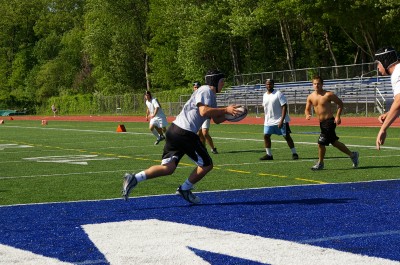Mel Mignucci ’12
A&E Editor

Two at a time, athletic adolescents sprint up and down the turf football field, from end to end, cheered on by their teammates. They finish the circuit in about a minute, barely panting and not visibly sweaty, even in the bright May sun. They exchange high fives, pats on the back, and watch as the next pair races.
The source of their stamina? Rugby– the sport with the “speed of soccer” and “intensity of football,” according to tri-captain Harry Rappaport ‘10.
To play rugby is simple. Fifteen players comprise a team, all of whom are involved in playing. Eight players assume the forward position, charged with getting and maintaining possession. The other seven play back to move the ball, which looks like a slightly more rounded football, around the field.
The team scores by making a try by touching the ball to the goal area, worth five points, which is followed by a two-point conversion, or a kick through the goalposts, or by kicking the ball through the goalposts while in play for three points.
No one can pass the ball forward, but they can kick it forward and pass it back. From there, opposing teams fight for the ball until whomever has possession is tackled. Now the game gets interesting.
Tackles can result in either a ruck or a maul, both described as “smotherpiles of men” by Jackson Moss ’12.
“When you’re tackled, you can either fall down or stay up,” Rappaport said. “A ruck is when you fall down and you have to kick the ball to your team to win possession,” he continued. Standing, he demonstrated a maul, the less common of the two, by locking his arm around co-captain Will Muchnick ’10 until Rappaport turned around, theoretically winning possession.
A scrum, the answer to a violation of the rules or a foul, is another “big pile of men,” according to Ryan Gilland ’13.
It is the reason why rugby players wear scrumcaps, which look like quilted head wraps with a chinstrap, and mouth guards to every practice. The eight forwards bunch up together and, as a singular body, fight the forwards of the other team for the ball.
According to Moss, rugby is not really that dangerous “unless people play dirty.” Gilland agreed, though they both could not practice due to injuries. “I broke my collarbone and then re-injured it 10 minutes back,” Gilland said.
Ten minutes on the field with these guys and it’s clear that not only love of the sport outweighs all potential for injury in the game, but also the relationship between the players. “It’s just a brotherhood that you don’t get from many sports,” Coach Joseph Barahona said.
When asked what contributes to this brotherhood, every single player walking off of the field chimed in. “Team chemistry,” Mikell Washington ’12 responded.
“You’re only as strong as your weakest player,” Eric Nebelung ’10 hypothesized.
“With rugby, you have to play with all 15 teammates. In football you can score with five,” said Rappaport. “Everybody’s involved.” Manchuck jumped in with a high-five for Rappaport, saying, “That’s why we go like this a lot.”
“Yeah, we head butt too,” said Rappaport, laughing.
The camaraderie extends beyond the individual team. “Our old coach used to say that he went to Ireland with $20 and a rugby ball,” said Rappaport, “and left with $20 and a rugby ball. He was given food, a place to stay, everything.”
“It’s a universal fraternity,” explained Barahona. “If you play rugby you will be accepted into any circle.”
“It’s for everyone,” he continued. “All it takes is a mouthpiece and a heart.”












































